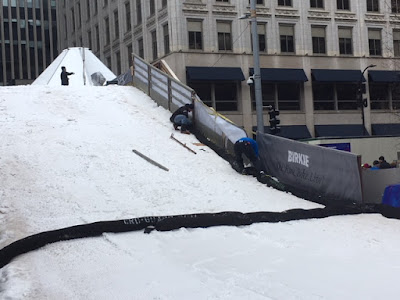 |
| [This was kinda cool.] |
I have mixed feelings about the experience, and wanted to jot them down before I forget. So here goes, the pros and cons of hosting a Super Bowl at least from an urbanist perspective.
1. OK the subsidies are gross
This should go without saying, but should also be said as much as possible: the Vikings stadium was a huge taxpayer giveaway to the Wilfs from New Jersey, who seem pretty terrible. Within the Super Bowl dealmaking, too, there were all kinds of shady details. It almost makes me glad that that Eagles fan stole a seat from the stadium.
2. Great choice of themes
The host committee theme – “the Bold North” – was a bit mockable, but I think it was a great choice. While single-digit temperatures weren’t the worst case, below zero, scenario, I’m sure that the cold temps gave nightmares to the civic booster crowd.
But the #boldNorth branding really did emphasize the aspirational embrace of winter that I think Minnesotans ought to have as a core part of our character. Just like Saint Paul’s ongoing Winter Carnival, we really ought to place winter at the center of our identity. Instead, for way too long, Minnesota’s first narrative reaction has been to retreat from winter and engineer it out of our daily lives.
I think “bold north” was great, and it worked even during an actual cold snap. I wish we had more of this kind of spirit in our media narratives, city planning, and daily lives.
3. Offered a glimpse of a dystopian corporate future
 |
| [Militarized, privatized, corporate downtown.] |
Oh yeah, dystopian science fiction like Children of Men, Idiocracy, Cosmopolis, The Road, Brazil, or a dozen other grim visions of the future. Only for a week or so, it was all happening in real life right here in Minneapolis.
Be wary, people. Be wary.
4. Economic impact was really mixed
Of course the fantastical promises of a million people and bazillions of free dollars raining in from all across the globe were extremely misleading, and actual economic studies have been debunking the claims of stadium boosters, convention boot-lickers, and the like for decades now.
The macro picture is not great, but at the micro level, from business to business, it was interesting to hear about places that were seeing a lot of benefit and those that weren’t. Of particular note was the way that skyway businesses did not seem to thrive downtown while street-level ones did better.
Partly that’s because almost all the bars are on the street level, but it’s also because streets and sidewalks are inherently legible spaces to people from all over the world. On the other hand, skyways are inherently confusing and alienating to those who are not used to them on an everyday level.
If downtown Minneapolis is going to be truly ambitious as a global city, that’s something to note, because…
5. Nicollet Mall is the focus of downtown (but isn’t)
 |
| [More cool stuff on Nicollet please.] |
But when the spotlight hits, only Nicollet can serve as the default public space for the city, the plaza and park that occupies the center of attention. I’d love to see the city double down on making Nicollet a true public space. I’d love it if downtown buildings began opening up to Nicollet, and if cafés, events, and people were thriving on Nicollet all year long. To my mind, the Super Bowl crowd during 5º weather proves that it’s possible.
6. The Twin Cities should dream big
Finally, the way that Minneapolis and Saint Paul did not wilt during the Super Bowl spotlight reminded me that we need to think bigger. It would be nice if our cities began measuring ourselves against truly global competition, if we had a transit system that ranked in the top #5 nationally, for example, or had sustainability footprints that competed with the best in Europe. There’s no reason why the Twin Cities can’t think bigger and more ambitiously about its future.
All in all, a weird but exciting experience with some pluses and minuses if you can get past the subsidy stuff.
2 comments:
Thanks for writing this, Bill. You've made some really good points here. I definitely got that corporate branding vibe and felt that slab of meat consumerism. Also, another positive and negative were the brick-sized wooden "Love" blocks around town that had a message encouraging folks to call and report if they see anything. The message felt like a terrorism threat reminder from the government, but the hand-painted blocks were referring to human trafficking, another form of terror that doesn't always get as much attention.
It would have been nice if planners had drawn some inspiration from Copenhagen and had some outside seating on Nicollet with blankets and heaters. Instead, we got pretty ugly temporary structures and an expensive carnival atmostphere.
Post a Comment